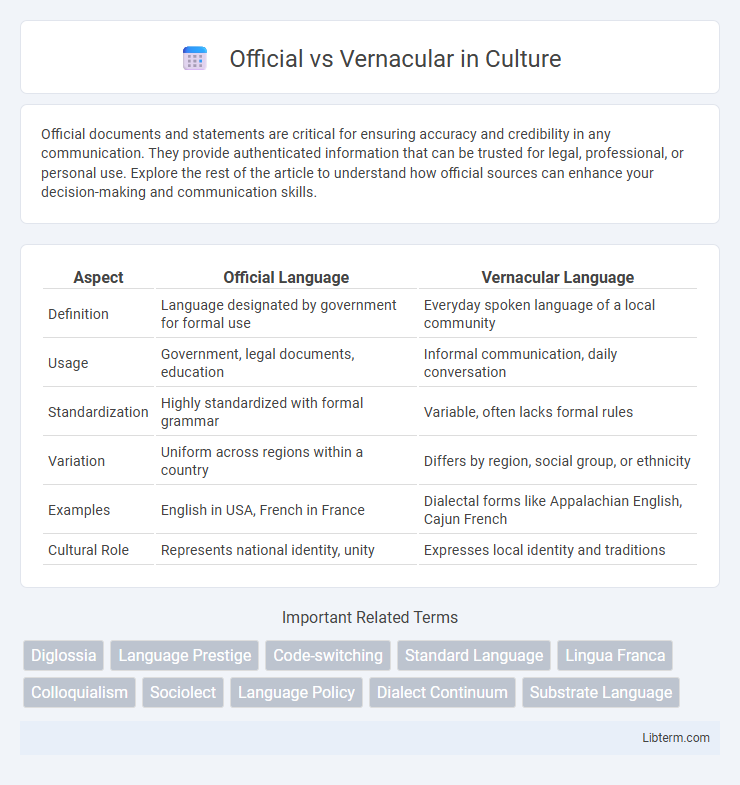Official documents and statements are critical for ensuring accuracy and credibility in any communication. They provide authenticated information that can be trusted for legal, professional, or personal use. Explore the rest of the article to understand how official sources can enhance your decision-making and communication skills.
Table of Comparison
| Aspect | Official Language | Vernacular Language |
|---|---|---|
| Definition | Language designated by government for formal use | Everyday spoken language of a local community |
| Usage | Government, legal documents, education | Informal communication, daily conversation |
| Standardization | Highly standardized with formal grammar | Variable, often lacks formal rules |
| Variation | Uniform across regions within a country | Differs by region, social group, or ethnicity |
| Examples | English in USA, French in France | Dialectal forms like Appalachian English, Cajun French |
| Cultural Role | Represents national identity, unity | Expresses local identity and traditions |
Understanding Official and Vernacular Languages
Official languages are designated by governments for use in legal, administrative, and formal communications, serving as standardized means of governance and education. Vernacular languages are the native or regional languages spoken by communities in daily life, reflecting cultural identity and local traditions. Understanding the distinction between official and vernacular languages highlights the balance between formal state functions and the preservation of linguistic diversity.
Historical Context of Language Usage
The distinction between official and vernacular languages has historically shaped administrative governance and cultural identity, with official languages often imposed by colonial powers or ruling elites to establish control and formal communication. Vernacular languages, spoken by the local population, preserved indigenous traditions and oral histories, serving as vehicles for cultural continuity despite official suppression. This dynamic influenced literacy rates, social stratification, and resistance movements, highlighting the critical role of language in historical power structures and identity formation.
Roles of Official Languages in Governance
Official languages serve as the primary medium for legislative processes, judiciary communication, and administrative functions within government institutions, ensuring uniformity and clarity in legal and bureaucratic matters. They facilitate effective governance by standardizing documentation, policy dissemination, and inter-departmental communication across diverse regions. In contrast, vernacular languages predominantly support local engagement and cultural expression without binding legal authority in official governmental operations.
Vernacular Languages and Cultural Identity
Vernacular languages serve as crucial vessels of cultural identity, preserving unique traditions, customs, and expressions within communities. They foster a sense of belonging and continuity by enabling everyday communication deeply rooted in local heritage. Maintaining vernacular languages supports cultural diversity and resists the homogenizing effects of global official languages.
Language Policy and Education
Language policy significantly influences the distinction between official and vernacular languages in educational systems. Official languages, often mandated by government policies, are used in formal education, administration, and legal settings to promote national unity and standardized communication. Vernacular languages, representing local and indigenous dialects, are crucial for cultural identity and mother-tongue instruction, enhancing cognitive development and learning outcomes among students in multilingual societies.
Communication Barriers and Social Inclusion
Official languages often dominate formal communication, creating barriers for speakers of vernacular languages who may struggle with access to essential services and participation in civic life. Vernacular languages carry cultural identity and promote social inclusion by enabling more effective communication within local communities and fostering a sense of belonging. Overlooking vernacular languages in policy and education can lead to marginalization, reducing social cohesion and limiting diverse representation.
Standardization vs. Linguistic Diversity
Official languages drive standardization by establishing uniform grammar, vocabulary, and usage norms essential for legal, educational, and administrative functions. Vernacular languages embody linguistic diversity, preserving regional identities and cultural heritage through unique dialects and oral traditions. Balancing official standardization with vernacular diversity promotes inclusive communication while respecting localized linguistic expressions.
Language Preservation and Endangerment
Official languages often receive government support and institutional backing, which aids their preservation through education, media, and legal frameworks. Vernacular languages, spoken primarily in local or informal settings, face higher risks of endangerment due to limited documentation, reduced intergenerational transmission, and socio-economic pressures favoring dominant official languages. Efforts to preserve endangered vernacular languages include community initiatives, digital archiving, and incorporation into local education systems to maintain linguistic diversity.
Media Representation of Languages
Media representation of languages often highlights the disparity between official and vernacular languages, where official languages dominate news broadcasts, formal publications, and government communications, reinforcing their prestige and authority. Vernacular languages, widely spoken in daily life and cultural expressions, receive less visibility in mainstream media, limiting their influence and perpetuating linguistic hierarchies. This imbalance impacts public perception, language preservation, and access to information among diverse linguistic communities.
Future Trends in Official and Vernacular Language Use
Future trends indicate a growing integration of vernacular languages into official domains, driven by digital communication platforms and localization technologies that enhance accessibility. Machine learning algorithms and natural language processing are enabling real-time translation and sentiment analysis, fostering broader acceptance and utility of vernacular languages in education and governance. Governments and organizations increasingly recognize linguistic diversity's value, prompting policies that support bilingualism and preserve endangered languages while promoting official language proficiency.
Official Infographic

 libterm.com
libterm.com